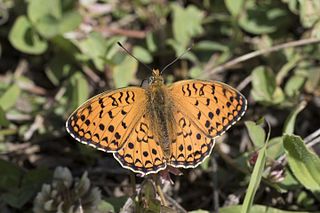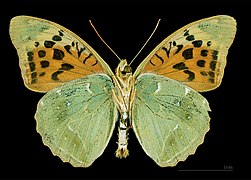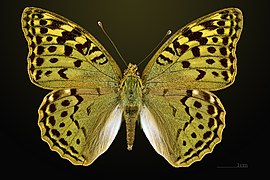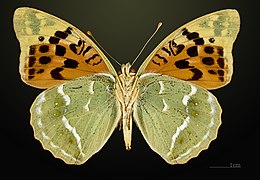
The silver-washed fritillary is a common and variable butterfly found over much of the Palearctic realm – Algeria, Europe and across the Palearctic to Japan.

The Niobe fritillary is a species of butterfly in the family Nymphalidae.

The scarce copper is a butterfly of the family Lycaenidae.

The Indian fritillary is a species of butterfly of the nymphalid or brush-footed family. It is usually found from south and southeast Asia to Australia.

Polyommatus eros, the Eros blue or common meadow blue, is a species of blue butterfly found in the Palearctic.

Colias palaeno, known by the common names moorland clouded yellow, palaeno sulphur, and pale Arctic clouded yellow, is a butterfly in the family Pieridae.

The black ringlet is a member of the subfamily Satyrinae of the family Nymphalidae. It is a high-altitude butterfly found in Albania, former Yugoslavia, Bulgaria, Greece, and Romania.

Boloria dia, the Weaver's fritillary or violet fritillary, is a butterfly in the family Nymphalidae. The name Weaver's fritillary is in honor of Richard Weaver, an English insect collector who claimed to have obtained the specimen within ten miles of Birmingham around 1820. However, B. dia is very rare in England and the few specimens known from there are thought to be from possibly accidental introductions.

Boloria titania, the Titania's fritillary or purple bog fritillary, is a butterfly of the subfamily Heliconiinae of the family Nymphalidae.

Melitaea didyma, the spotted fritillary or red-band fritillary, is a Palearctic butterfly of the family Nymphalidae.

Aricia nicias, the silvery argus, is a butterfly of the family Lycaenidae. It is found in the Alps, Pyrenees and from Scandinavia ranging to Siberia and the north of Mongolia.

Polyommatus damon, the Damon blue, is a butterfly of the family Lycaenidae.

Argynnis laodice, Pallas' fritillary, is a butterfly of the family Nymphalidae. It occurs in damp forested places in southern Scandinavia, Eastern Europe, northwestern Kazakhstan, and across the Palearctic to Siberia, Amur, Korea and Japan.

Chazara briseis, the hermit, is a butterfly species belonging to the family Nymphalidae. It can be found in North Africa, southern Europe, Asia Minor, the Caucasus, Kazakhstan, Central Asia through Afghanistan, and north-western China and Tuva. It is found on steppe and in other dry grassy places between 500 and 2,500 meters.

Boloria pales, the shepherd's fritillary, is a butterfly of the family Nymphalidae. It is found from the Cantabrian Mountains and the Pyrenees through the Alps and Apennine Mountains east to the Balkan, Carpathian Mountains, the Caucasus and central Asia up to western China.

The twin-spot fritillary is a butterfly in the family Nymphalidae.

Arethusana is a butterfly genus from the subfamily Satyrinae of the brush-footed butterfly family (Nymphalidae). It is composed of only one species, Arethusana arethusa, the false grayling.

Colias cocandica is a butterfly in the family Pieridae. It is found in Central Asia.

Issoria eugenia is a small butterfly found in the East Palearctic that belongs to the family Nymphalidae.

Polyommatus damone is a Palearctic butterfly in the Lycaenidae family.


























